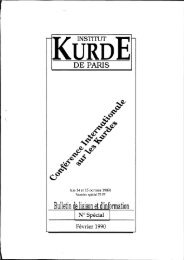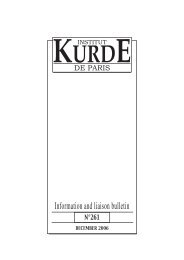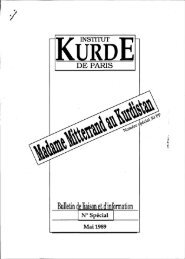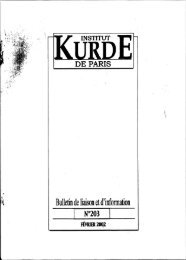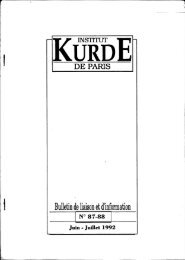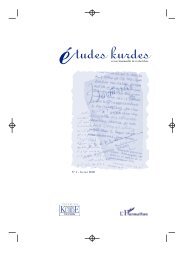Bulletin de liaison et d'information - Institut kurde de Paris
Bulletin de liaison et d'information - Institut kurde de Paris
Bulletin de liaison et d'information - Institut kurde de Paris
Create successful ePaper yourself
Turn your PDF publications into a flip-book with our unique Google optimized e-Paper software.
REVUE DE PRESSE-PRESS<br />
REVIEW-BERHEVOKA ÇAPÊ-RIVISTA STAMPA-DENTRO DE LA PRENSA-BASIN ÖZETi<br />
Iran's social and economic indicators in<br />
pre-revolution and post-revolution periods<br />
The following is a comparison of major<br />
social and econ~mic in<strong>de</strong>xes b<strong>et</strong>ween the two<br />
pre-revolution periods in 1rall. However, the<br />
]ollowing points are to be noted in advance:<br />
1) In the period b<strong>et</strong>ween 1974 and 1977, an<br />
upsur~e in oil earnings and unrestrained lift<br />
from tne country's oil reserves had provi<strong>de</strong>d the<br />
Shah's regime with huge sources of hard currency,<br />
the bulk of which was allocated to the<br />
import of consumption goods to provi<strong>de</strong> an artifiCIal<br />
welfare in the country. Therefore, some<br />
welfare in<strong>de</strong>xes which <strong>de</strong>pen<strong>de</strong>d on imported<br />
goods during those years do not reflect the real-<br />
Ities of the country' s economy.<br />
2) The policy of the Shah's regime was based<br />
on the maximum lift from the country' s<br />
exhaustible oil resources, and lift from the oil<br />
reserves, during those years, amounted to 6 million<br />
barrels/er<br />
reserves ha<br />
day (bpd). If lift from the oil<br />
continued at the same pace and<br />
level, given the amount of the then discovered<br />
oil reserves of the country, the life of the<br />
reserves could no: exceed 30 years at most.<br />
After the revolution, the amount of lift from oil<br />
reserves was reduced to less than half, and<br />
given the newly discovered oil reserves and the<br />
low rate of lift, the life of the country's oil<br />
reserves is now estimated to last for another 60<br />
or 70 years.<br />
3) During t1)ose years, the amount of hard<br />
currency spent on imported goods and services<br />
reached<br />
regard<br />
$25 billion<br />
to the annual<br />
per annum. And, with<br />
inflation of imported<br />
goods, if Iran had attempted to import the same<br />
amount of goods and services in recent years. it<br />
would have had to spend over $50 billion. 4)<br />
The population of the country, with an increase<br />
of 70 percent during the past<br />
from 35 million to around<br />
15 years, has risen<br />
60 million. It is<br />
inevitable that with the rapid increase of the<br />
population, the problems of me<strong>et</strong>ing its needs<br />
also increase at a progressive rate and the<br />
resulting pressure<br />
about substantial<br />
on economic<br />
difficulties.<br />
resources<br />
In view<br />
brin$s<br />
of tne<br />
population growth rate, if the annual hard currency<br />
spending had to be maintained on fixed<br />
prices, Iran would have to spend over $80 billion<br />
on imports<br />
thé explanation<br />
in recent years. With regard to<br />
given above, some major social<br />
and economic in<strong>de</strong>xes b<strong>et</strong>ween the said periods<br />
are compared as follows:<br />
1) Education<br />
One of the characteristics of the population<br />
of the country in the post-revolution area is its<br />
youth. This characteristic puts a heavier bur<strong>de</strong>n<br />
on the shoul<strong>de</strong>rs of the government in terms of<br />
health care, education and employment.<br />
According to the existing statistics, the number<br />
of the country's stu<strong>de</strong>nts rose from 6.9 million<br />
in 1975 to 8.5 million in 1977. In or<strong>de</strong>r to<br />
me<strong>et</strong> the educational needs of these stu<strong>de</strong>nts,<br />
600<br />
500<br />
400<br />
300<br />
200<br />
100<br />
o<br />
• Jan. - Oct. Period.<br />
Tra<strong>de</strong> relations b<strong>et</strong>ween Iran and Turkey ($ Million)<br />
1991<br />
1992<br />
the Ministry of Education has had to build<br />
around 270,000 new classrooms across Iran<br />
durin& the post-revolution years, and the number<br />
or classrooms had risen from 194.600 in<br />
1977 to 463,000 in 1991. Like.wise, the number<br />
of the country's instructors has risen from<br />
around 252,000 in 1977 to 585,000 in 1991.<br />
The literacy figures during those years also<br />
point to a great accomplishment in this regard.<br />
According to those figures, the ratio of literacy<br />
in the entire country has increased from 49.13<br />
percent in 1977 to 74.3 percent in 1991. This<br />
ratio has increased from 32.2 percent to 63.1<br />
percent in the rural population, and from 67<br />
percent to 82.5 percent in the urban population.<br />
2) Agricultural products<br />
In the post-revolution era, the agricultural<br />
sector of Iran has been granted a special status<br />
as the sector which contributes to the in<strong>de</strong>pen<strong>de</strong>nce<br />
and self-sufficiency of the country.<br />
During this period, with the implementation of<br />
vast supportive policies in the sector, a majority<br />
of major items of agricultural products have<br />
enjoyed a growth rate faster than that of the<br />
population. For instance, the production of<br />
wheat, as a strategic crop, barley and cereals<br />
has increased respectively from 5.5 million, 1.2<br />
million and 225,000 tons in 1977 to !O.3 million,<br />
3.6 million and 650,000 tons in 1992. In<br />
other words, during this period, the production<br />
of wheat has doubled, and the production of<br />
barley and .cereals has tripled. The production<br />
of rice, dunng the same period. has risen from<br />
1.4 milhon to 2.1 million tons, showing an<br />
increase<br />
1992*<br />
of 50 percent.<br />
1993*<br />
Ilmports<br />
fom.lran<br />
3) Industrial'products<br />
In the industnal sector too, <strong>de</strong>spite the problems<br />
of the war, economic blocka<strong>de</strong> and hard<br />
currency shortages, accomplishments have been<br />
achieved, mostly in the postwar years.<br />
In this sector, the manufacture of iron and<br />
steel, with the consi<strong>de</strong>rable investments ma<strong>de</strong>,<br />
increased from 2 million tons in 1977 to 4 million<br />
tons in 1991, and the production of cement<br />
also rose from 6.3 million tons to 14 million<br />
tons. During the same period. the production of<br />
vea<strong>et</strong>able oil increased from 300,000 to<br />
62Ô,000 tons, and the production of p'asteurized<br />
milk rose from 164 million to 421 million liters.<br />
4) Power generation<br />
In the post-revolution years, special attention<br />
has been paid to the <strong>de</strong>velopment<br />
try's infrastructures. Meanwhile,<br />
of the coun-<br />
the country's<br />
power industry. <strong>de</strong>spite the nee<strong>de</strong>d huge investments<br />
and the existmg<br />
very fast growth. The<br />
problems,<br />
country's<br />
has enjoyed a<br />
annual power<br />
generation increased from 19 billion kilowatts<br />
10 1977 to more than 64 billion kilowatts in<br />
1991, and this amount will further increase with<br />
new power plants to be s<strong>et</strong> into operation.<br />
Therefore, in view of the fact that power generation<br />
has enjoyed a growth rate hißher than that<br />
of the population,~the country s per capita<br />
power<br />
watts<br />
generation has increased from<br />
In 1977 to \, I 04 kilowatts<br />
542 kilo-<br />
in 1991.<br />
During these years, rower .supply to the rllral<br />
areas has won speçia attentIOn, and thl' number<br />
163





